Analysis of Employee Turnover and Motivation in Hong Kong Hotels
VerifiedAdded on 2019/10/08
|25
|6949
|265
Report
AI Summary
This report investigates contemporary issues in business, specifically focusing on work motivation and employee turnover within the hospitality sector of Hong Kong, using the JW Marriott Hotel as a case study. The report begins with an abstract outlining the need for employee motivation in the hospitality sector and its impact on turnover intentions. It then delves into the justification of the topic's relevance, highlighting the importance of employee retention and motivation in the HRM function and its effect on business outcomes. The aim and objectives of the study are to identify the key factors that motivate employees and impact turnover. A comprehensive literature review examines the dependent variable, employee turnover, defining its role and determinants. The review explores three independent variables: shortage of skilled labor, lack of rewards and recognition, and lack of effective training and development. The report analyzes how these factors influence employee turnover, providing a theoretical framework and discussion of managerial implications, and concludes with recommendations to improve employee motivation and retention, offering valuable insights for the management of the JW Marriott Hotel Hong Kong.
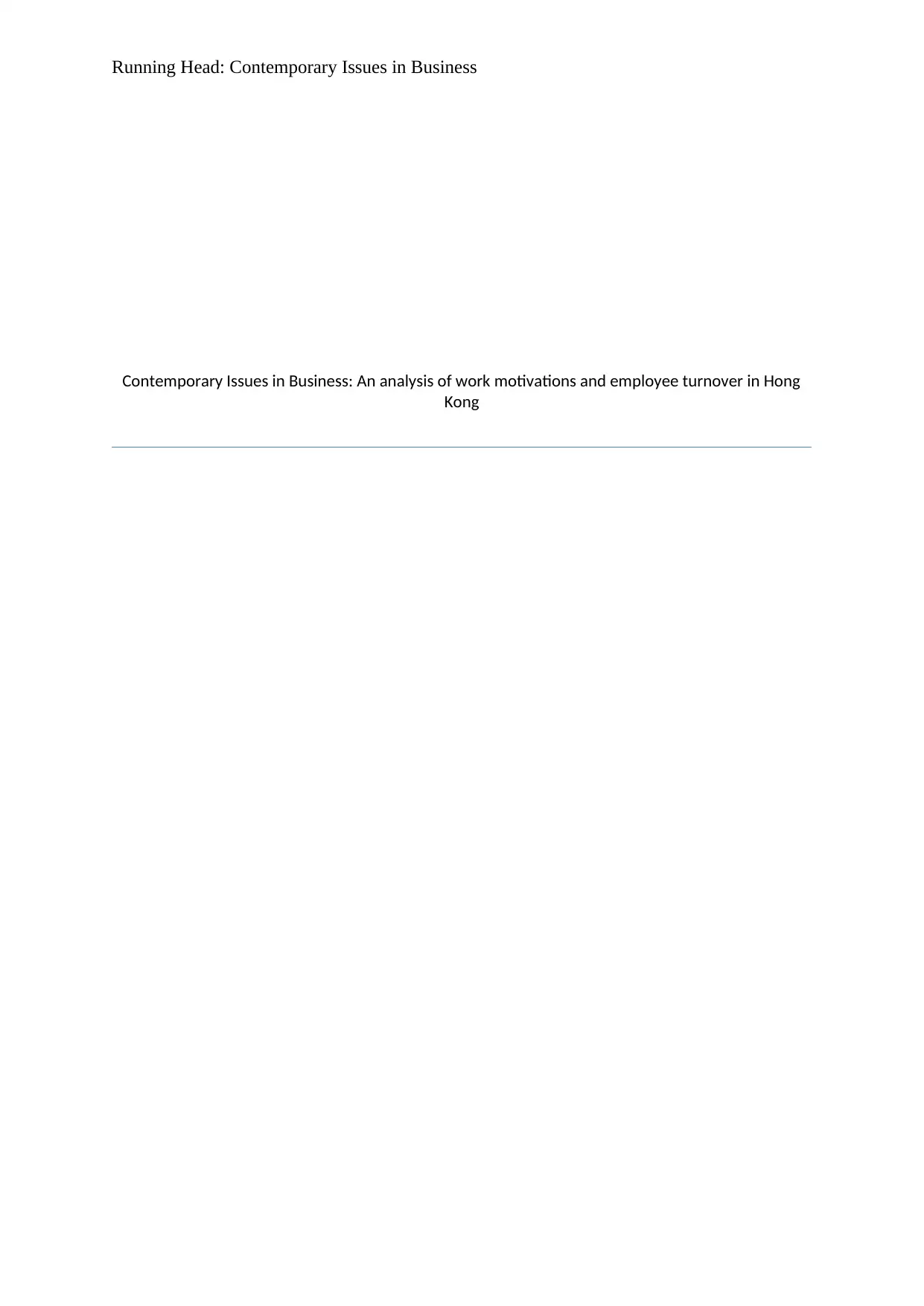
Running Head: Contemporary Issues in Business
Contemporary Issues in Business: An analysis of work motivations and employee turnover in Hong
Kong
Contemporary Issues in Business: An analysis of work motivations and employee turnover in Hong
Kong
Paraphrase This Document
Need a fresh take? Get an instant paraphrase of this document with our AI Paraphraser
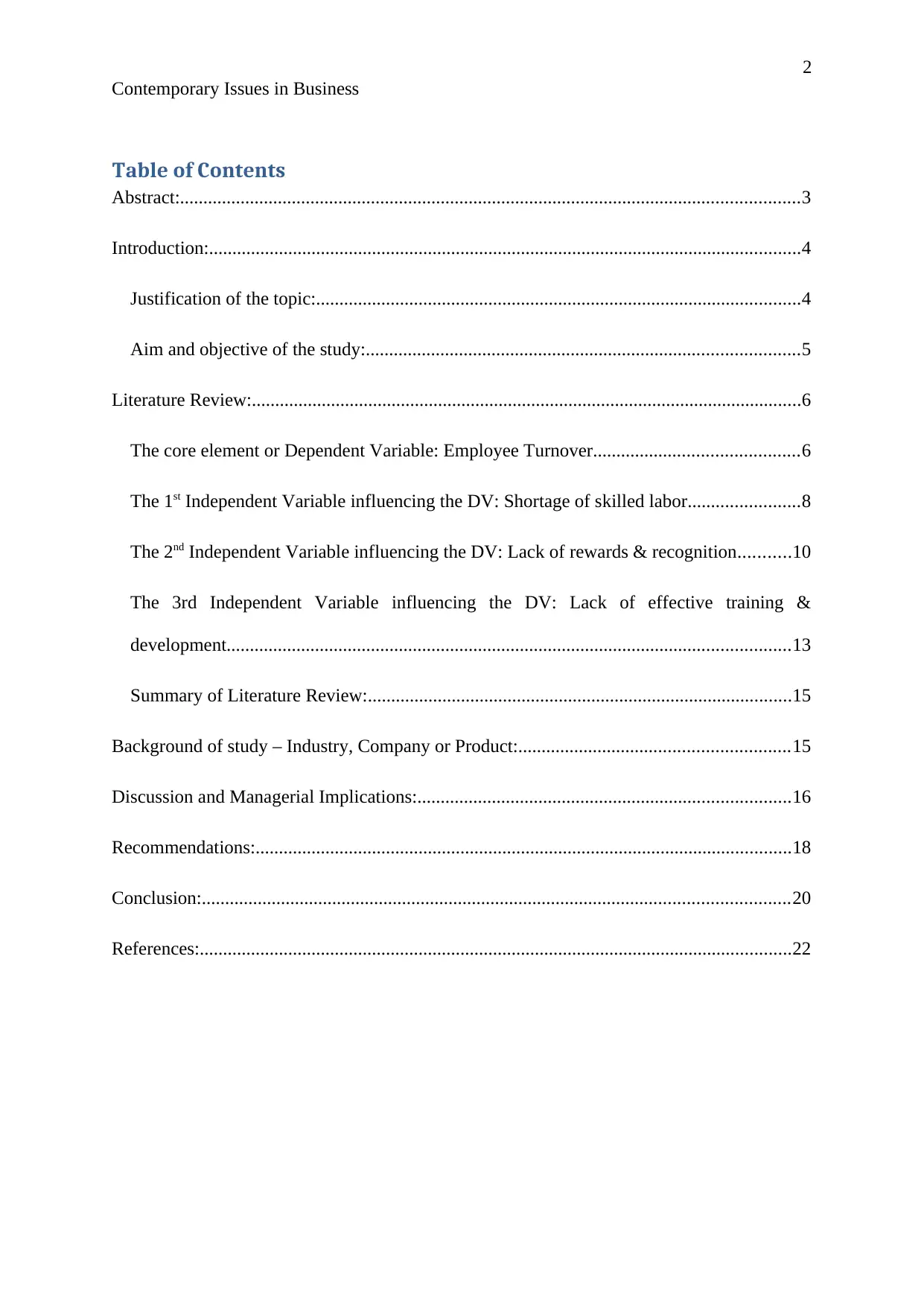
2
Contemporary Issues in Business
Table of Contents
Abstract:.....................................................................................................................................3
Introduction:...............................................................................................................................4
Justification of the topic:........................................................................................................4
Aim and objective of the study:.............................................................................................5
Literature Review:......................................................................................................................6
The core element or Dependent Variable: Employee Turnover............................................6
The 1st Independent Variable influencing the DV: Shortage of skilled labor........................8
The 2nd Independent Variable influencing the DV: Lack of rewards & recognition...........10
The 3rd Independent Variable influencing the DV: Lack of effective training &
development.........................................................................................................................13
Summary of Literature Review:...........................................................................................15
Background of study – Industry, Company or Product:..........................................................15
Discussion and Managerial Implications:................................................................................16
Recommendations:...................................................................................................................18
Conclusion:..............................................................................................................................20
References:...............................................................................................................................22
Contemporary Issues in Business
Table of Contents
Abstract:.....................................................................................................................................3
Introduction:...............................................................................................................................4
Justification of the topic:........................................................................................................4
Aim and objective of the study:.............................................................................................5
Literature Review:......................................................................................................................6
The core element or Dependent Variable: Employee Turnover............................................6
The 1st Independent Variable influencing the DV: Shortage of skilled labor........................8
The 2nd Independent Variable influencing the DV: Lack of rewards & recognition...........10
The 3rd Independent Variable influencing the DV: Lack of effective training &
development.........................................................................................................................13
Summary of Literature Review:...........................................................................................15
Background of study – Industry, Company or Product:..........................................................15
Discussion and Managerial Implications:................................................................................16
Recommendations:...................................................................................................................18
Conclusion:..............................................................................................................................20
References:...............................................................................................................................22
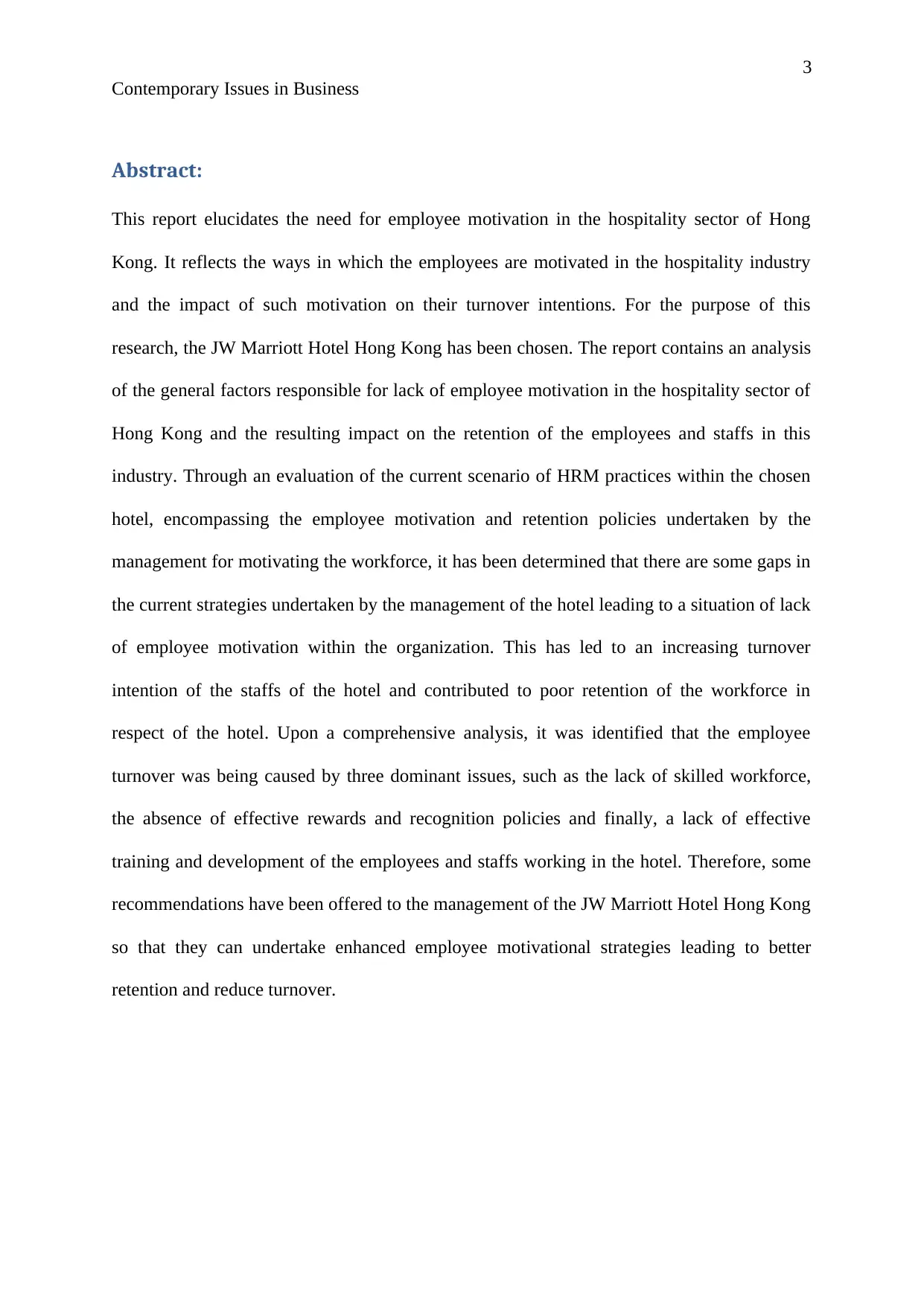
3
Contemporary Issues in Business
Abstract:
This report elucidates the need for employee motivation in the hospitality sector of Hong
Kong. It reflects the ways in which the employees are motivated in the hospitality industry
and the impact of such motivation on their turnover intentions. For the purpose of this
research, the JW Marriott Hotel Hong Kong has been chosen. The report contains an analysis
of the general factors responsible for lack of employee motivation in the hospitality sector of
Hong Kong and the resulting impact on the retention of the employees and staffs in this
industry. Through an evaluation of the current scenario of HRM practices within the chosen
hotel, encompassing the employee motivation and retention policies undertaken by the
management for motivating the workforce, it has been determined that there are some gaps in
the current strategies undertaken by the management of the hotel leading to a situation of lack
of employee motivation within the organization. This has led to an increasing turnover
intention of the staffs of the hotel and contributed to poor retention of the workforce in
respect of the hotel. Upon a comprehensive analysis, it was identified that the employee
turnover was being caused by three dominant issues, such as the lack of skilled workforce,
the absence of effective rewards and recognition policies and finally, a lack of effective
training and development of the employees and staffs working in the hotel. Therefore, some
recommendations have been offered to the management of the JW Marriott Hotel Hong Kong
so that they can undertake enhanced employee motivational strategies leading to better
retention and reduce turnover.
Contemporary Issues in Business
Abstract:
This report elucidates the need for employee motivation in the hospitality sector of Hong
Kong. It reflects the ways in which the employees are motivated in the hospitality industry
and the impact of such motivation on their turnover intentions. For the purpose of this
research, the JW Marriott Hotel Hong Kong has been chosen. The report contains an analysis
of the general factors responsible for lack of employee motivation in the hospitality sector of
Hong Kong and the resulting impact on the retention of the employees and staffs in this
industry. Through an evaluation of the current scenario of HRM practices within the chosen
hotel, encompassing the employee motivation and retention policies undertaken by the
management for motivating the workforce, it has been determined that there are some gaps in
the current strategies undertaken by the management of the hotel leading to a situation of lack
of employee motivation within the organization. This has led to an increasing turnover
intention of the staffs of the hotel and contributed to poor retention of the workforce in
respect of the hotel. Upon a comprehensive analysis, it was identified that the employee
turnover was being caused by three dominant issues, such as the lack of skilled workforce,
the absence of effective rewards and recognition policies and finally, a lack of effective
training and development of the employees and staffs working in the hotel. Therefore, some
recommendations have been offered to the management of the JW Marriott Hotel Hong Kong
so that they can undertake enhanced employee motivational strategies leading to better
retention and reduce turnover.
⊘ This is a preview!⊘
Do you want full access?
Subscribe today to unlock all pages.

Trusted by 1+ million students worldwide
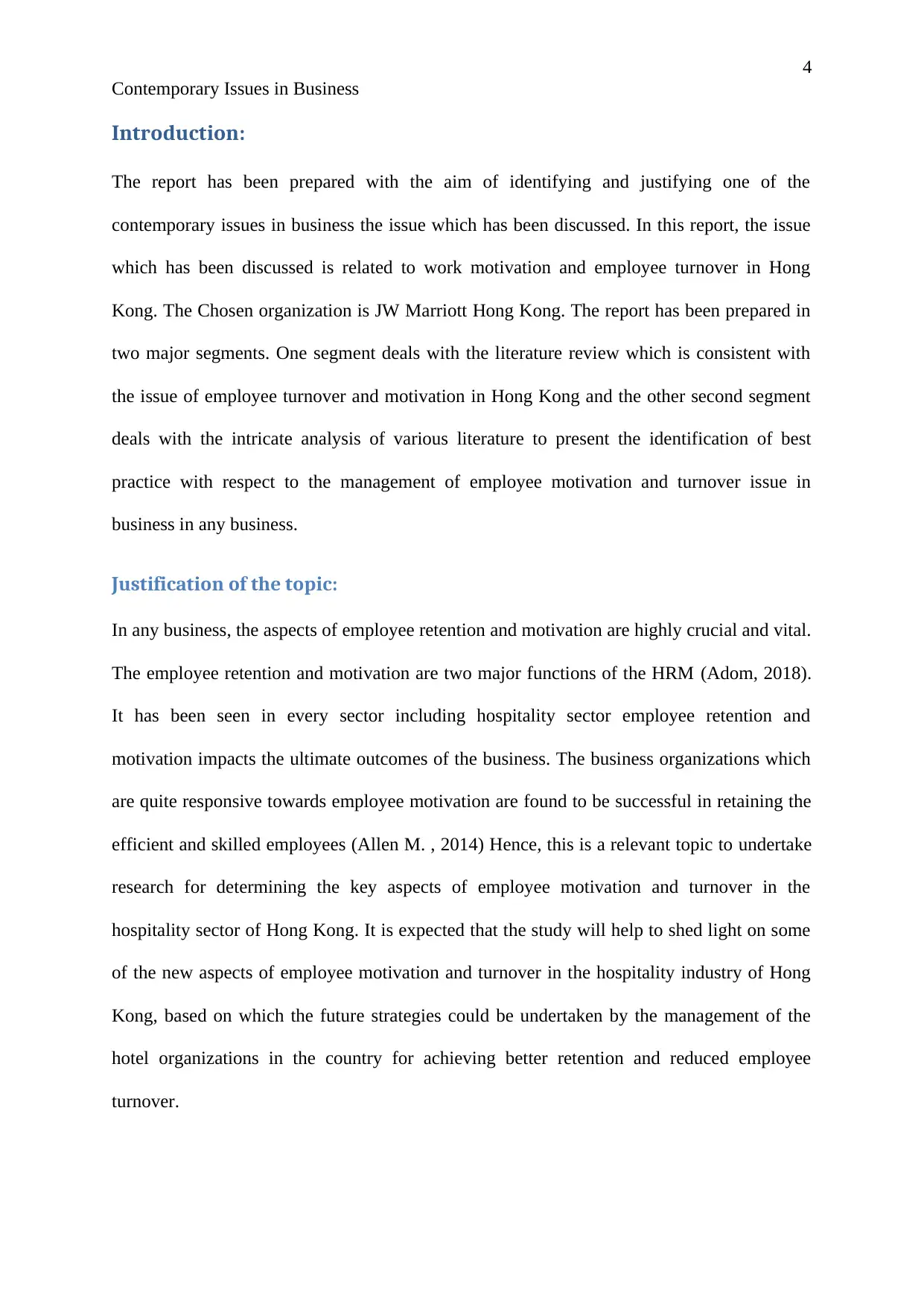
4
Contemporary Issues in Business
Introduction:
The report has been prepared with the aim of identifying and justifying one of the
contemporary issues in business the issue which has been discussed. In this report, the issue
which has been discussed is related to work motivation and employee turnover in Hong
Kong. The Chosen organization is JW Marriott Hong Kong. The report has been prepared in
two major segments. One segment deals with the literature review which is consistent with
the issue of employee turnover and motivation in Hong Kong and the other second segment
deals with the intricate analysis of various literature to present the identification of best
practice with respect to the management of employee motivation and turnover issue in
business in any business.
Justification of the topic:
In any business, the aspects of employee retention and motivation are highly crucial and vital.
The employee retention and motivation are two major functions of the HRM (Adom, 2018).
It has been seen in every sector including hospitality sector employee retention and
motivation impacts the ultimate outcomes of the business. The business organizations which
are quite responsive towards employee motivation are found to be successful in retaining the
efficient and skilled employees (Allen M. , 2014) Hence, this is a relevant topic to undertake
research for determining the key aspects of employee motivation and turnover in the
hospitality sector of Hong Kong. It is expected that the study will help to shed light on some
of the new aspects of employee motivation and turnover in the hospitality industry of Hong
Kong, based on which the future strategies could be undertaken by the management of the
hotel organizations in the country for achieving better retention and reduced employee
turnover.
Contemporary Issues in Business
Introduction:
The report has been prepared with the aim of identifying and justifying one of the
contemporary issues in business the issue which has been discussed. In this report, the issue
which has been discussed is related to work motivation and employee turnover in Hong
Kong. The Chosen organization is JW Marriott Hong Kong. The report has been prepared in
two major segments. One segment deals with the literature review which is consistent with
the issue of employee turnover and motivation in Hong Kong and the other second segment
deals with the intricate analysis of various literature to present the identification of best
practice with respect to the management of employee motivation and turnover issue in
business in any business.
Justification of the topic:
In any business, the aspects of employee retention and motivation are highly crucial and vital.
The employee retention and motivation are two major functions of the HRM (Adom, 2018).
It has been seen in every sector including hospitality sector employee retention and
motivation impacts the ultimate outcomes of the business. The business organizations which
are quite responsive towards employee motivation are found to be successful in retaining the
efficient and skilled employees (Allen M. , 2014) Hence, this is a relevant topic to undertake
research for determining the key aspects of employee motivation and turnover in the
hospitality sector of Hong Kong. It is expected that the study will help to shed light on some
of the new aspects of employee motivation and turnover in the hospitality industry of Hong
Kong, based on which the future strategies could be undertaken by the management of the
hotel organizations in the country for achieving better retention and reduced employee
turnover.
Paraphrase This Document
Need a fresh take? Get an instant paraphrase of this document with our AI Paraphraser
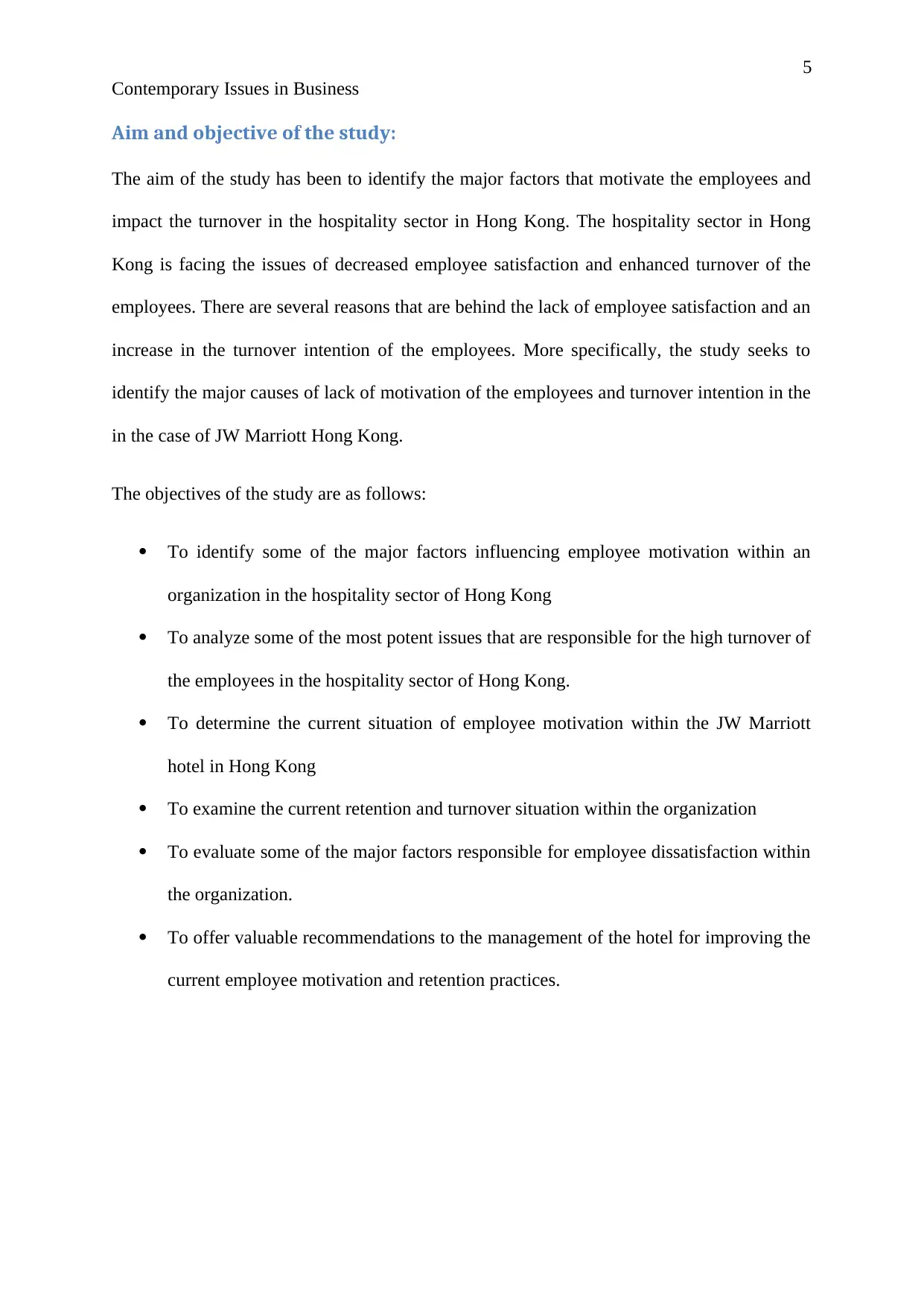
5
Contemporary Issues in Business
Aim and objective of the study:
The aim of the study has been to identify the major factors that motivate the employees and
impact the turnover in the hospitality sector in Hong Kong. The hospitality sector in Hong
Kong is facing the issues of decreased employee satisfaction and enhanced turnover of the
employees. There are several reasons that are behind the lack of employee satisfaction and an
increase in the turnover intention of the employees. More specifically, the study seeks to
identify the major causes of lack of motivation of the employees and turnover intention in the
in the case of JW Marriott Hong Kong.
The objectives of the study are as follows:
To identify some of the major factors influencing employee motivation within an
organization in the hospitality sector of Hong Kong
To analyze some of the most potent issues that are responsible for the high turnover of
the employees in the hospitality sector of Hong Kong.
To determine the current situation of employee motivation within the JW Marriott
hotel in Hong Kong
To examine the current retention and turnover situation within the organization
To evaluate some of the major factors responsible for employee dissatisfaction within
the organization.
To offer valuable recommendations to the management of the hotel for improving the
current employee motivation and retention practices.
Contemporary Issues in Business
Aim and objective of the study:
The aim of the study has been to identify the major factors that motivate the employees and
impact the turnover in the hospitality sector in Hong Kong. The hospitality sector in Hong
Kong is facing the issues of decreased employee satisfaction and enhanced turnover of the
employees. There are several reasons that are behind the lack of employee satisfaction and an
increase in the turnover intention of the employees. More specifically, the study seeks to
identify the major causes of lack of motivation of the employees and turnover intention in the
in the case of JW Marriott Hong Kong.
The objectives of the study are as follows:
To identify some of the major factors influencing employee motivation within an
organization in the hospitality sector of Hong Kong
To analyze some of the most potent issues that are responsible for the high turnover of
the employees in the hospitality sector of Hong Kong.
To determine the current situation of employee motivation within the JW Marriott
hotel in Hong Kong
To examine the current retention and turnover situation within the organization
To evaluate some of the major factors responsible for employee dissatisfaction within
the organization.
To offer valuable recommendations to the management of the hotel for improving the
current employee motivation and retention practices.
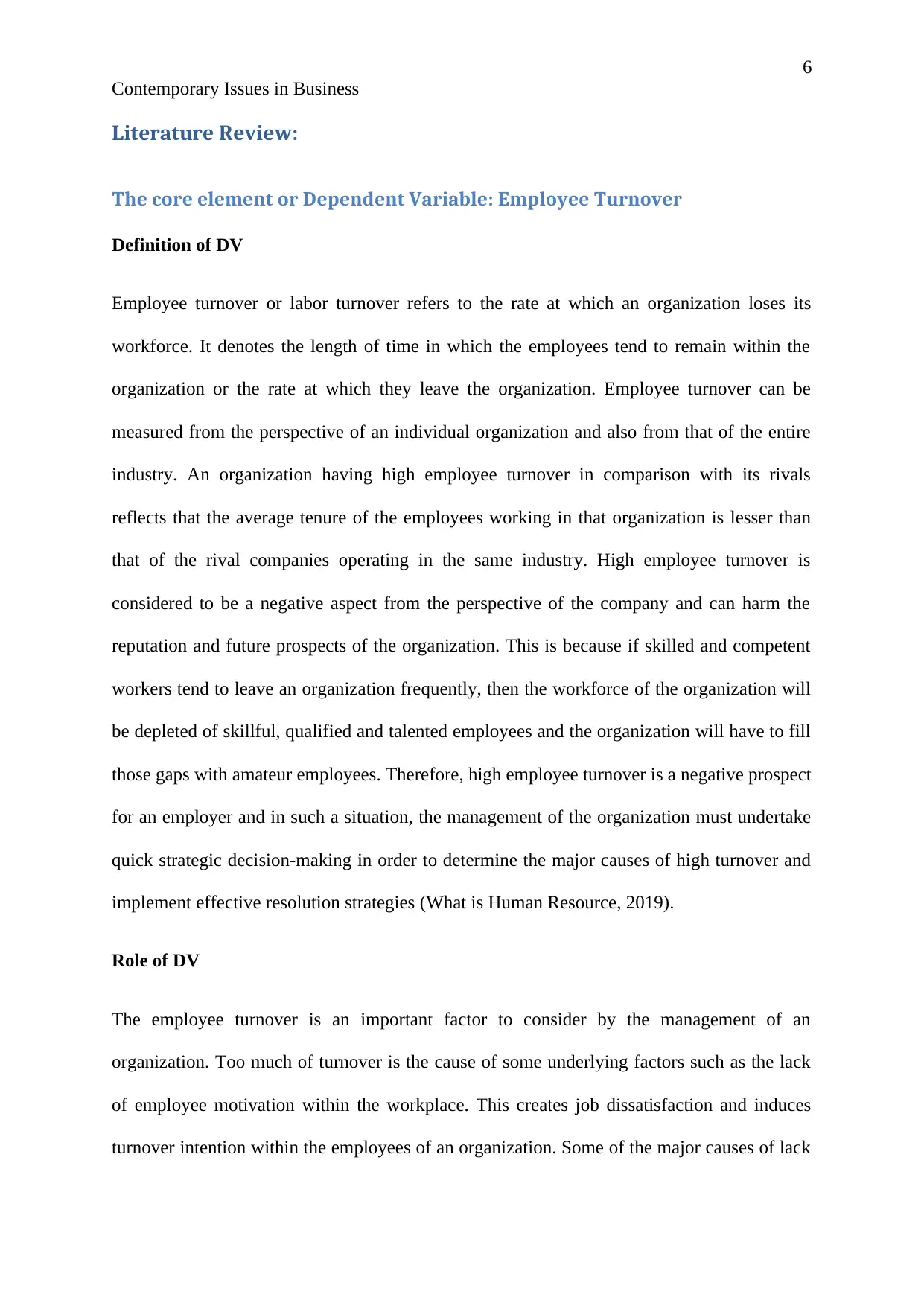
6
Contemporary Issues in Business
Literature Review:
The core element or Dependent Variable: Employee Turnover
Definition of DV
Employee turnover or labor turnover refers to the rate at which an organization loses its
workforce. It denotes the length of time in which the employees tend to remain within the
organization or the rate at which they leave the organization. Employee turnover can be
measured from the perspective of an individual organization and also from that of the entire
industry. An organization having high employee turnover in comparison with its rivals
reflects that the average tenure of the employees working in that organization is lesser than
that of the rival companies operating in the same industry. High employee turnover is
considered to be a negative aspect from the perspective of the company and can harm the
reputation and future prospects of the organization. This is because if skilled and competent
workers tend to leave an organization frequently, then the workforce of the organization will
be depleted of skillful, qualified and talented employees and the organization will have to fill
those gaps with amateur employees. Therefore, high employee turnover is a negative prospect
for an employer and in such a situation, the management of the organization must undertake
quick strategic decision-making in order to determine the major causes of high turnover and
implement effective resolution strategies (What is Human Resource, 2019).
Role of DV
The employee turnover is an important factor to consider by the management of an
organization. Too much of turnover is the cause of some underlying factors such as the lack
of employee motivation within the workplace. This creates job dissatisfaction and induces
turnover intention within the employees of an organization. Some of the major causes of lack
Contemporary Issues in Business
Literature Review:
The core element or Dependent Variable: Employee Turnover
Definition of DV
Employee turnover or labor turnover refers to the rate at which an organization loses its
workforce. It denotes the length of time in which the employees tend to remain within the
organization or the rate at which they leave the organization. Employee turnover can be
measured from the perspective of an individual organization and also from that of the entire
industry. An organization having high employee turnover in comparison with its rivals
reflects that the average tenure of the employees working in that organization is lesser than
that of the rival companies operating in the same industry. High employee turnover is
considered to be a negative aspect from the perspective of the company and can harm the
reputation and future prospects of the organization. This is because if skilled and competent
workers tend to leave an organization frequently, then the workforce of the organization will
be depleted of skillful, qualified and talented employees and the organization will have to fill
those gaps with amateur employees. Therefore, high employee turnover is a negative prospect
for an employer and in such a situation, the management of the organization must undertake
quick strategic decision-making in order to determine the major causes of high turnover and
implement effective resolution strategies (What is Human Resource, 2019).
Role of DV
The employee turnover is an important factor to consider by the management of an
organization. Too much of turnover is the cause of some underlying factors such as the lack
of employee motivation within the workplace. This creates job dissatisfaction and induces
turnover intention within the employees of an organization. Some of the major causes of lack
⊘ This is a preview!⊘
Do you want full access?
Subscribe today to unlock all pages.

Trusted by 1+ million students worldwide
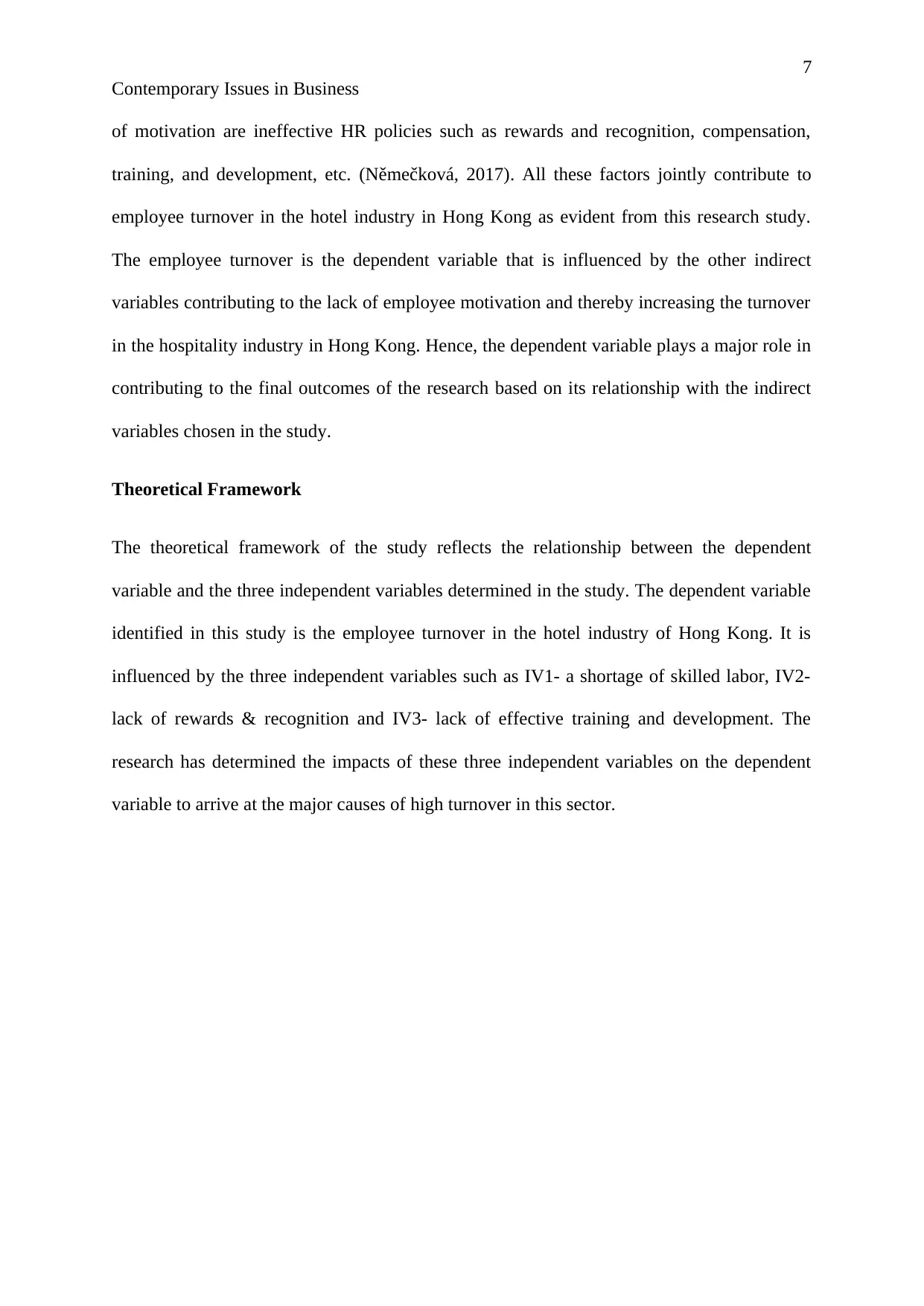
7
Contemporary Issues in Business
of motivation are ineffective HR policies such as rewards and recognition, compensation,
training, and development, etc. (Němečková, 2017). All these factors jointly contribute to
employee turnover in the hotel industry in Hong Kong as evident from this research study.
The employee turnover is the dependent variable that is influenced by the other indirect
variables contributing to the lack of employee motivation and thereby increasing the turnover
in the hospitality industry in Hong Kong. Hence, the dependent variable plays a major role in
contributing to the final outcomes of the research based on its relationship with the indirect
variables chosen in the study.
Theoretical Framework
The theoretical framework of the study reflects the relationship between the dependent
variable and the three independent variables determined in the study. The dependent variable
identified in this study is the employee turnover in the hotel industry of Hong Kong. It is
influenced by the three independent variables such as IV1- a shortage of skilled labor, IV2-
lack of rewards & recognition and IV3- lack of effective training and development. The
research has determined the impacts of these three independent variables on the dependent
variable to arrive at the major causes of high turnover in this sector.
Contemporary Issues in Business
of motivation are ineffective HR policies such as rewards and recognition, compensation,
training, and development, etc. (Němečková, 2017). All these factors jointly contribute to
employee turnover in the hotel industry in Hong Kong as evident from this research study.
The employee turnover is the dependent variable that is influenced by the other indirect
variables contributing to the lack of employee motivation and thereby increasing the turnover
in the hospitality industry in Hong Kong. Hence, the dependent variable plays a major role in
contributing to the final outcomes of the research based on its relationship with the indirect
variables chosen in the study.
Theoretical Framework
The theoretical framework of the study reflects the relationship between the dependent
variable and the three independent variables determined in the study. The dependent variable
identified in this study is the employee turnover in the hotel industry of Hong Kong. It is
influenced by the three independent variables such as IV1- a shortage of skilled labor, IV2-
lack of rewards & recognition and IV3- lack of effective training and development. The
research has determined the impacts of these three independent variables on the dependent
variable to arrive at the major causes of high turnover in this sector.
Paraphrase This Document
Need a fresh take? Get an instant paraphrase of this document with our AI Paraphraser
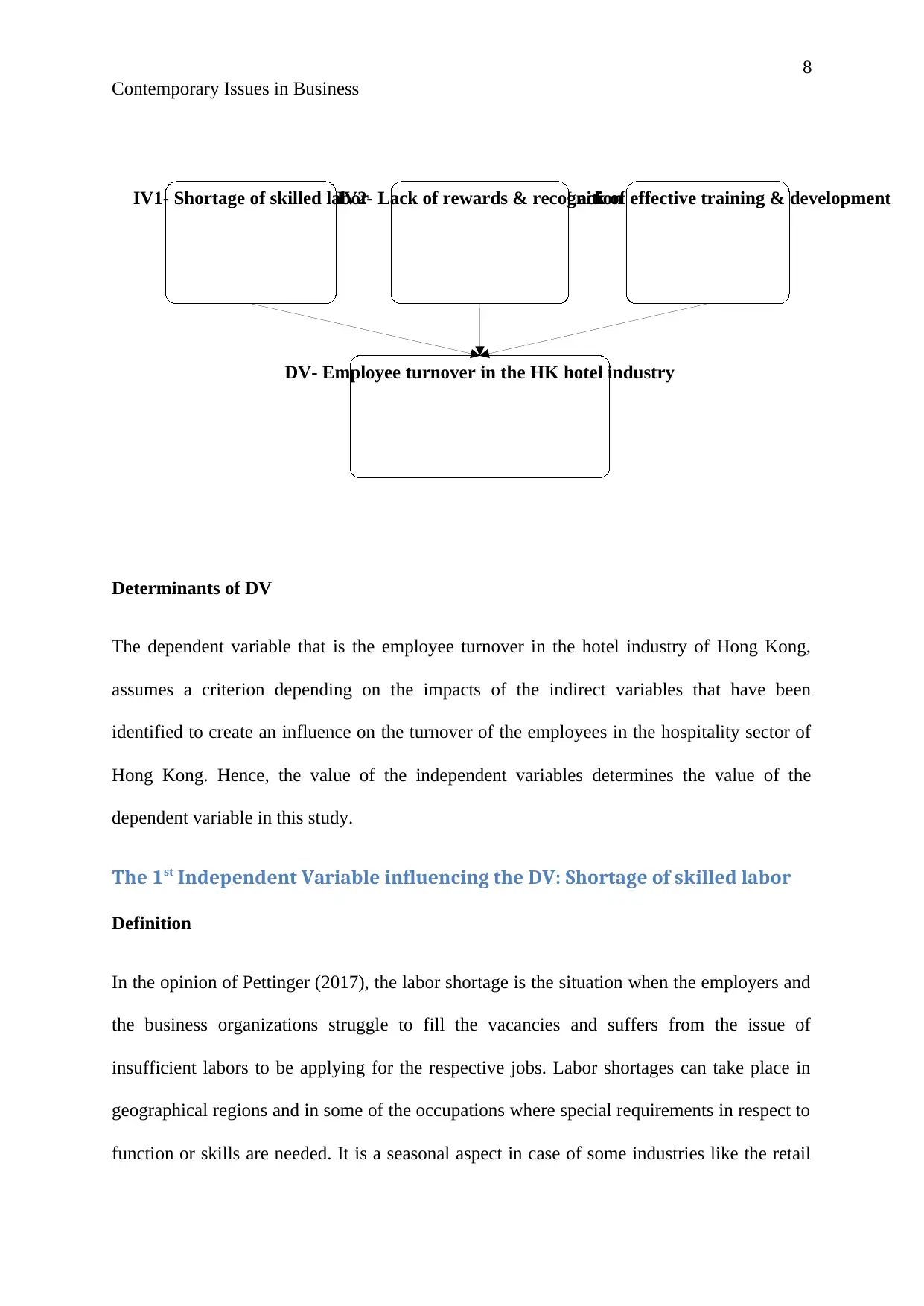
DV- Employee turnover in the HK hotel industry
IV1- Shortage of skilled labor IV3- Lack of effective training & developmentIV2- Lack of rewards & recognition
8
Contemporary Issues in Business
Determinants of DV
The dependent variable that is the employee turnover in the hotel industry of Hong Kong,
assumes a criterion depending on the impacts of the indirect variables that have been
identified to create an influence on the turnover of the employees in the hospitality sector of
Hong Kong. Hence, the value of the independent variables determines the value of the
dependent variable in this study.
The 1st Independent Variable influencing the DV: Shortage of skilled labor
Definition
In the opinion of Pettinger (2017), the labor shortage is the situation when the employers and
the business organizations struggle to fill the vacancies and suffers from the issue of
insufficient labors to be applying for the respective jobs. Labor shortages can take place in
geographical regions and in some of the occupations where special requirements in respect to
function or skills are needed. It is a seasonal aspect in case of some industries like the retail
IV1- Shortage of skilled labor IV3- Lack of effective training & developmentIV2- Lack of rewards & recognition
8
Contemporary Issues in Business
Determinants of DV
The dependent variable that is the employee turnover in the hotel industry of Hong Kong,
assumes a criterion depending on the impacts of the indirect variables that have been
identified to create an influence on the turnover of the employees in the hospitality sector of
Hong Kong. Hence, the value of the independent variables determines the value of the
dependent variable in this study.
The 1st Independent Variable influencing the DV: Shortage of skilled labor
Definition
In the opinion of Pettinger (2017), the labor shortage is the situation when the employers and
the business organizations struggle to fill the vacancies and suffers from the issue of
insufficient labors to be applying for the respective jobs. Labor shortages can take place in
geographical regions and in some of the occupations where special requirements in respect to
function or skills are needed. It is a seasonal aspect in case of some industries like the retail
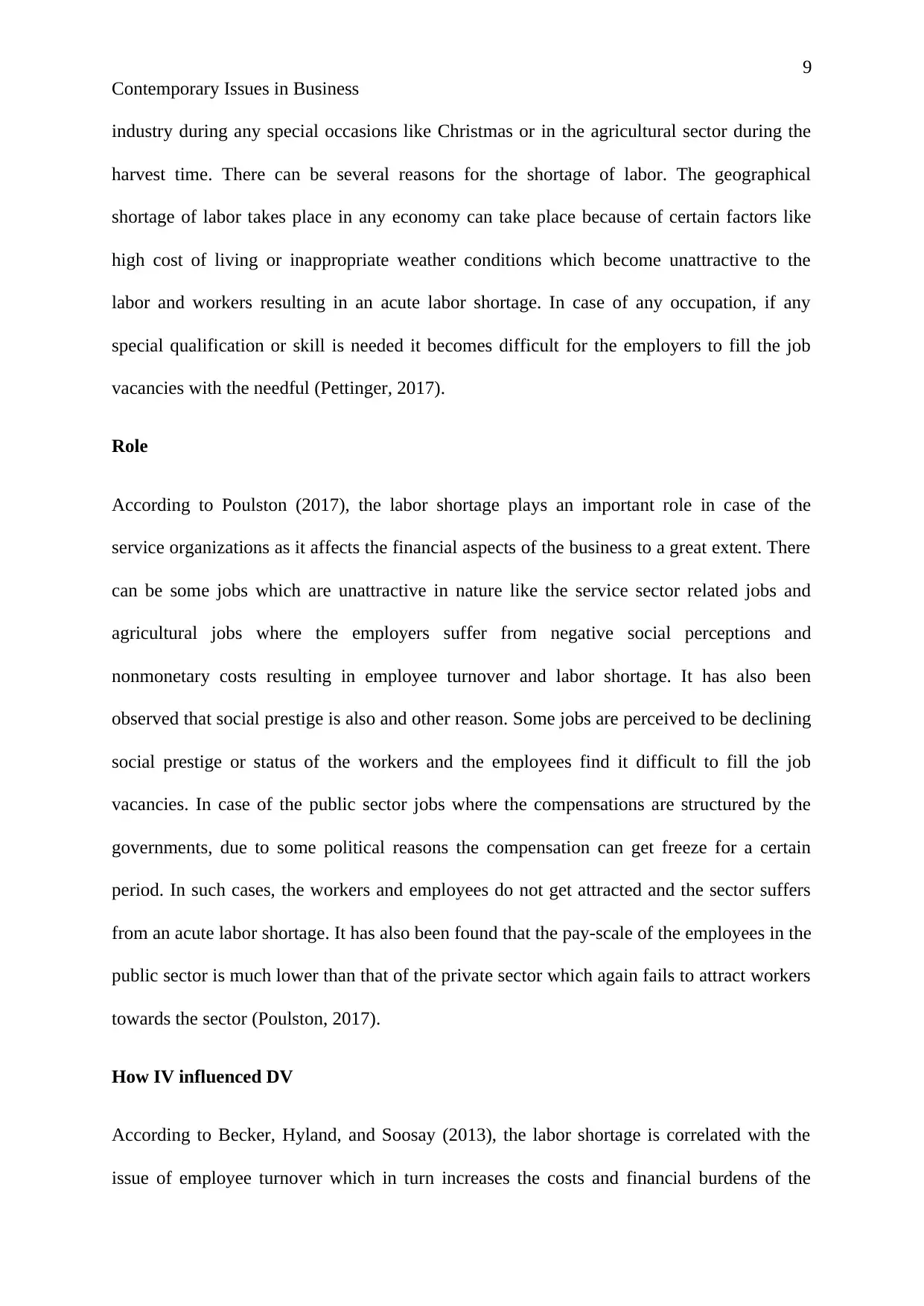
9
Contemporary Issues in Business
industry during any special occasions like Christmas or in the agricultural sector during the
harvest time. There can be several reasons for the shortage of labor. The geographical
shortage of labor takes place in any economy can take place because of certain factors like
high cost of living or inappropriate weather conditions which become unattractive to the
labor and workers resulting in an acute labor shortage. In case of any occupation, if any
special qualification or skill is needed it becomes difficult for the employers to fill the job
vacancies with the needful (Pettinger, 2017).
Role
According to Poulston (2017), the labor shortage plays an important role in case of the
service organizations as it affects the financial aspects of the business to a great extent. There
can be some jobs which are unattractive in nature like the service sector related jobs and
agricultural jobs where the employers suffer from negative social perceptions and
nonmonetary costs resulting in employee turnover and labor shortage. It has also been
observed that social prestige is also and other reason. Some jobs are perceived to be declining
social prestige or status of the workers and the employees find it difficult to fill the job
vacancies. In case of the public sector jobs where the compensations are structured by the
governments, due to some political reasons the compensation can get freeze for a certain
period. In such cases, the workers and employees do not get attracted and the sector suffers
from an acute labor shortage. It has also been found that the pay-scale of the employees in the
public sector is much lower than that of the private sector which again fails to attract workers
towards the sector (Poulston, 2017).
How IV influenced DV
According to Becker, Hyland, and Soosay (2013), the labor shortage is correlated with the
issue of employee turnover which in turn increases the costs and financial burdens of the
Contemporary Issues in Business
industry during any special occasions like Christmas or in the agricultural sector during the
harvest time. There can be several reasons for the shortage of labor. The geographical
shortage of labor takes place in any economy can take place because of certain factors like
high cost of living or inappropriate weather conditions which become unattractive to the
labor and workers resulting in an acute labor shortage. In case of any occupation, if any
special qualification or skill is needed it becomes difficult for the employers to fill the job
vacancies with the needful (Pettinger, 2017).
Role
According to Poulston (2017), the labor shortage plays an important role in case of the
service organizations as it affects the financial aspects of the business to a great extent. There
can be some jobs which are unattractive in nature like the service sector related jobs and
agricultural jobs where the employers suffer from negative social perceptions and
nonmonetary costs resulting in employee turnover and labor shortage. It has also been
observed that social prestige is also and other reason. Some jobs are perceived to be declining
social prestige or status of the workers and the employees find it difficult to fill the job
vacancies. In case of the public sector jobs where the compensations are structured by the
governments, due to some political reasons the compensation can get freeze for a certain
period. In such cases, the workers and employees do not get attracted and the sector suffers
from an acute labor shortage. It has also been found that the pay-scale of the employees in the
public sector is much lower than that of the private sector which again fails to attract workers
towards the sector (Poulston, 2017).
How IV influenced DV
According to Becker, Hyland, and Soosay (2013), the labor shortage is correlated with the
issue of employee turnover which in turn increases the costs and financial burdens of the
⊘ This is a preview!⊘
Do you want full access?
Subscribe today to unlock all pages.

Trusted by 1+ million students worldwide
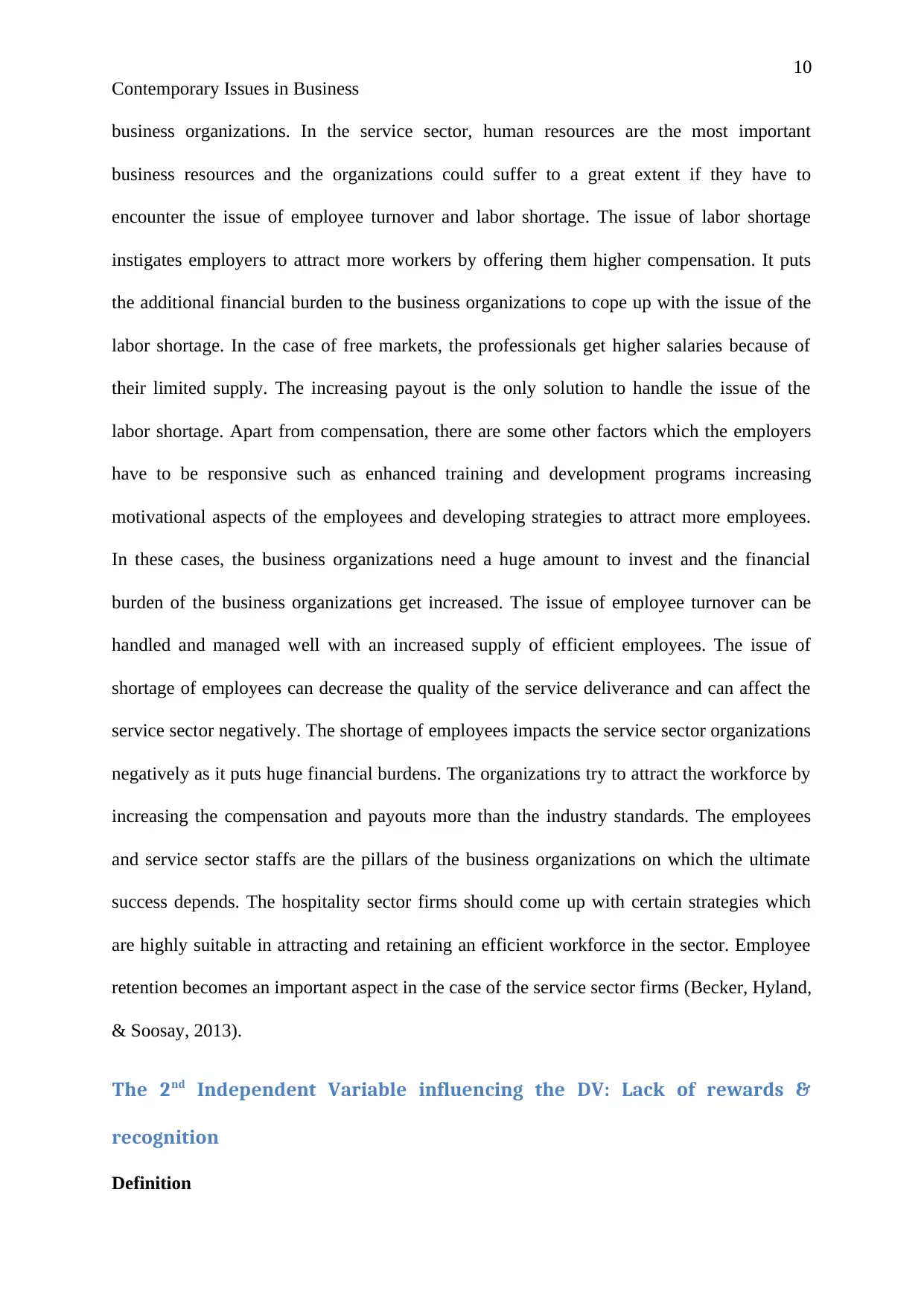
10
Contemporary Issues in Business
business organizations. In the service sector, human resources are the most important
business resources and the organizations could suffer to a great extent if they have to
encounter the issue of employee turnover and labor shortage. The issue of labor shortage
instigates employers to attract more workers by offering them higher compensation. It puts
the additional financial burden to the business organizations to cope up with the issue of the
labor shortage. In the case of free markets, the professionals get higher salaries because of
their limited supply. The increasing payout is the only solution to handle the issue of the
labor shortage. Apart from compensation, there are some other factors which the employers
have to be responsive such as enhanced training and development programs increasing
motivational aspects of the employees and developing strategies to attract more employees.
In these cases, the business organizations need a huge amount to invest and the financial
burden of the business organizations get increased. The issue of employee turnover can be
handled and managed well with an increased supply of efficient employees. The issue of
shortage of employees can decrease the quality of the service deliverance and can affect the
service sector negatively. The shortage of employees impacts the service sector organizations
negatively as it puts huge financial burdens. The organizations try to attract the workforce by
increasing the compensation and payouts more than the industry standards. The employees
and service sector staffs are the pillars of the business organizations on which the ultimate
success depends. The hospitality sector firms should come up with certain strategies which
are highly suitable in attracting and retaining an efficient workforce in the sector. Employee
retention becomes an important aspect in the case of the service sector firms (Becker, Hyland,
& Soosay, 2013).
The 2nd Independent Variable influencing the DV: Lack of rewards &
recognition
Definition
Contemporary Issues in Business
business organizations. In the service sector, human resources are the most important
business resources and the organizations could suffer to a great extent if they have to
encounter the issue of employee turnover and labor shortage. The issue of labor shortage
instigates employers to attract more workers by offering them higher compensation. It puts
the additional financial burden to the business organizations to cope up with the issue of the
labor shortage. In the case of free markets, the professionals get higher salaries because of
their limited supply. The increasing payout is the only solution to handle the issue of the
labor shortage. Apart from compensation, there are some other factors which the employers
have to be responsive such as enhanced training and development programs increasing
motivational aspects of the employees and developing strategies to attract more employees.
In these cases, the business organizations need a huge amount to invest and the financial
burden of the business organizations get increased. The issue of employee turnover can be
handled and managed well with an increased supply of efficient employees. The issue of
shortage of employees can decrease the quality of the service deliverance and can affect the
service sector negatively. The shortage of employees impacts the service sector organizations
negatively as it puts huge financial burdens. The organizations try to attract the workforce by
increasing the compensation and payouts more than the industry standards. The employees
and service sector staffs are the pillars of the business organizations on which the ultimate
success depends. The hospitality sector firms should come up with certain strategies which
are highly suitable in attracting and retaining an efficient workforce in the sector. Employee
retention becomes an important aspect in the case of the service sector firms (Becker, Hyland,
& Soosay, 2013).
The 2nd Independent Variable influencing the DV: Lack of rewards &
recognition
Definition
Paraphrase This Document
Need a fresh take? Get an instant paraphrase of this document with our AI Paraphraser
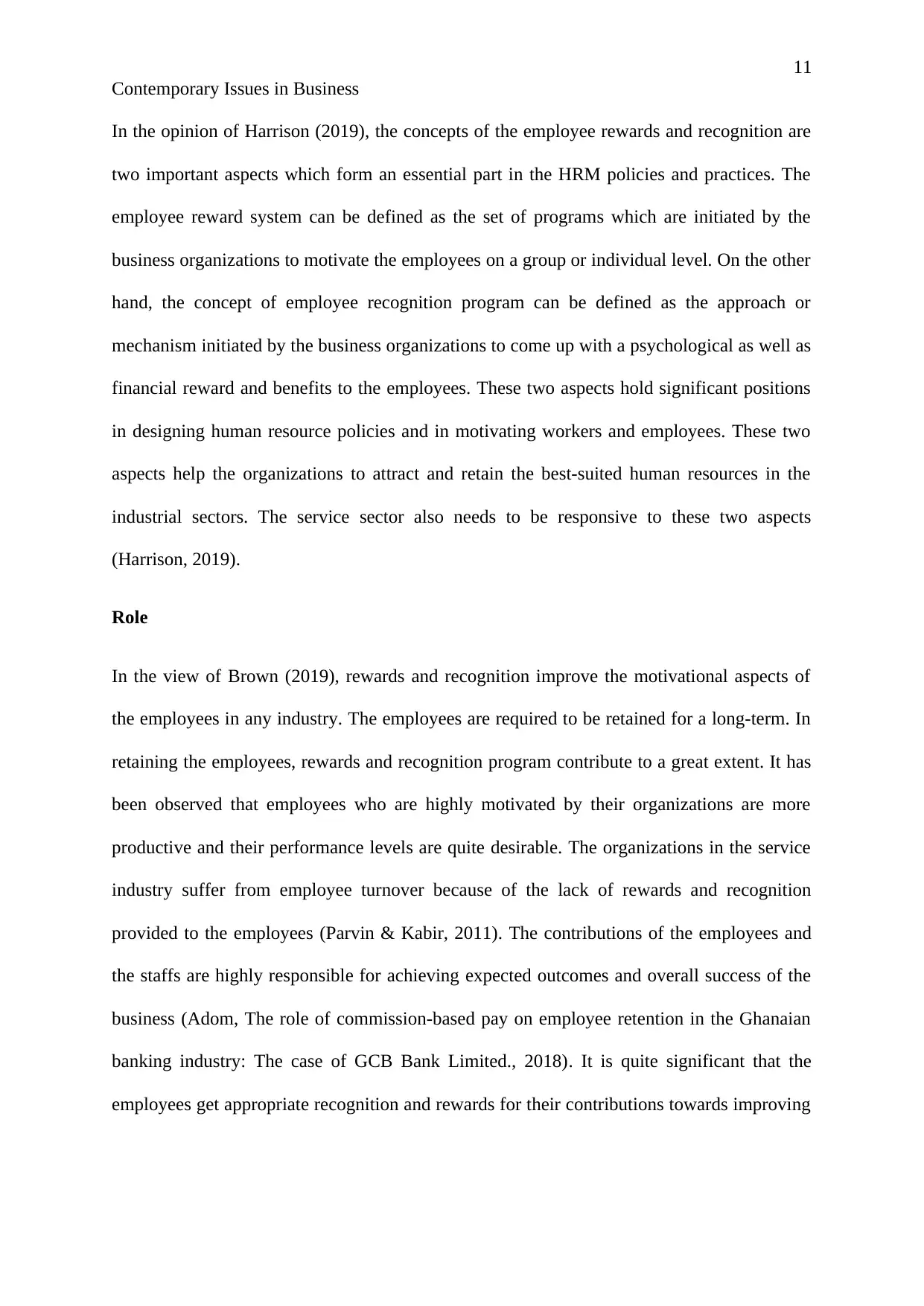
11
Contemporary Issues in Business
In the opinion of Harrison (2019), the concepts of the employee rewards and recognition are
two important aspects which form an essential part in the HRM policies and practices. The
employee reward system can be defined as the set of programs which are initiated by the
business organizations to motivate the employees on a group or individual level. On the other
hand, the concept of employee recognition program can be defined as the approach or
mechanism initiated by the business organizations to come up with a psychological as well as
financial reward and benefits to the employees. These two aspects hold significant positions
in designing human resource policies and in motivating workers and employees. These two
aspects help the organizations to attract and retain the best-suited human resources in the
industrial sectors. The service sector also needs to be responsive to these two aspects
(Harrison, 2019).
Role
In the view of Brown (2019), rewards and recognition improve the motivational aspects of
the employees in any industry. The employees are required to be retained for a long-term. In
retaining the employees, rewards and recognition program contribute to a great extent. It has
been observed that employees who are highly motivated by their organizations are more
productive and their performance levels are quite desirable. The organizations in the service
industry suffer from employee turnover because of the lack of rewards and recognition
provided to the employees (Parvin & Kabir, 2011). The contributions of the employees and
the staffs are highly responsible for achieving expected outcomes and overall success of the
business (Adom, The role of commission-based pay on employee retention in the Ghanaian
banking industry: The case of GCB Bank Limited., 2018). It is quite significant that the
employees get appropriate recognition and rewards for their contributions towards improving
Contemporary Issues in Business
In the opinion of Harrison (2019), the concepts of the employee rewards and recognition are
two important aspects which form an essential part in the HRM policies and practices. The
employee reward system can be defined as the set of programs which are initiated by the
business organizations to motivate the employees on a group or individual level. On the other
hand, the concept of employee recognition program can be defined as the approach or
mechanism initiated by the business organizations to come up with a psychological as well as
financial reward and benefits to the employees. These two aspects hold significant positions
in designing human resource policies and in motivating workers and employees. These two
aspects help the organizations to attract and retain the best-suited human resources in the
industrial sectors. The service sector also needs to be responsive to these two aspects
(Harrison, 2019).
Role
In the view of Brown (2019), rewards and recognition improve the motivational aspects of
the employees in any industry. The employees are required to be retained for a long-term. In
retaining the employees, rewards and recognition program contribute to a great extent. It has
been observed that employees who are highly motivated by their organizations are more
productive and their performance levels are quite desirable. The organizations in the service
industry suffer from employee turnover because of the lack of rewards and recognition
provided to the employees (Parvin & Kabir, 2011). The contributions of the employees and
the staffs are highly responsible for achieving expected outcomes and overall success of the
business (Adom, The role of commission-based pay on employee retention in the Ghanaian
banking industry: The case of GCB Bank Limited., 2018). It is quite significant that the
employees get appropriate recognition and rewards for their contributions towards improving
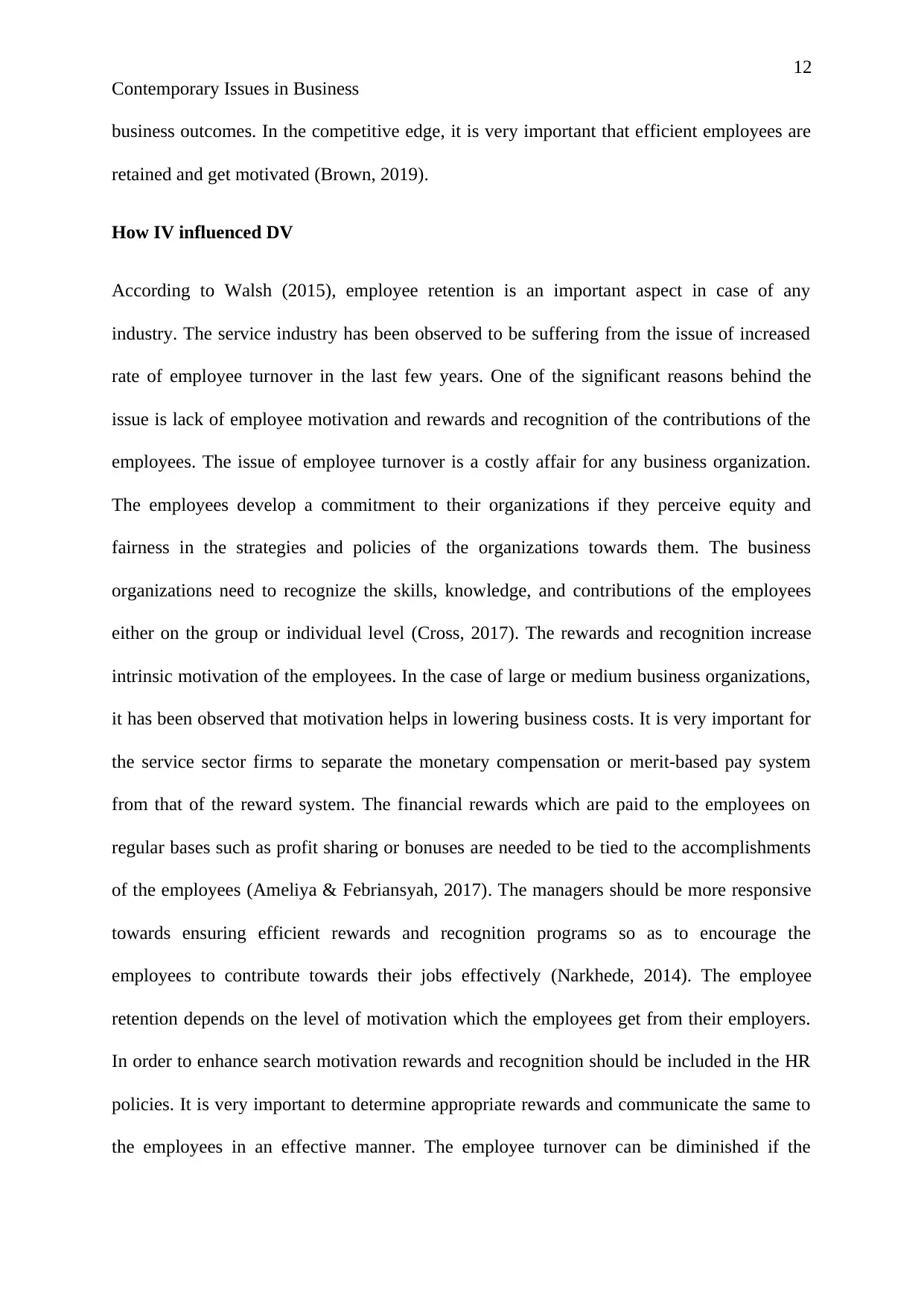
12
Contemporary Issues in Business
business outcomes. In the competitive edge, it is very important that efficient employees are
retained and get motivated (Brown, 2019).
How IV influenced DV
According to Walsh (2015), employee retention is an important aspect in case of any
industry. The service industry has been observed to be suffering from the issue of increased
rate of employee turnover in the last few years. One of the significant reasons behind the
issue is lack of employee motivation and rewards and recognition of the contributions of the
employees. The issue of employee turnover is a costly affair for any business organization.
The employees develop a commitment to their organizations if they perceive equity and
fairness in the strategies and policies of the organizations towards them. The business
organizations need to recognize the skills, knowledge, and contributions of the employees
either on the group or individual level (Cross, 2017). The rewards and recognition increase
intrinsic motivation of the employees. In the case of large or medium business organizations,
it has been observed that motivation helps in lowering business costs. It is very important for
the service sector firms to separate the monetary compensation or merit-based pay system
from that of the reward system. The financial rewards which are paid to the employees on
regular bases such as profit sharing or bonuses are needed to be tied to the accomplishments
of the employees (Ameliya & Febriansyah, 2017). The managers should be more responsive
towards ensuring efficient rewards and recognition programs so as to encourage the
employees to contribute towards their jobs effectively (Narkhede, 2014). The employee
retention depends on the level of motivation which the employees get from their employers.
In order to enhance search motivation rewards and recognition should be included in the HR
policies. It is very important to determine appropriate rewards and communicate the same to
the employees in an effective manner. The employee turnover can be diminished if the
Contemporary Issues in Business
business outcomes. In the competitive edge, it is very important that efficient employees are
retained and get motivated (Brown, 2019).
How IV influenced DV
According to Walsh (2015), employee retention is an important aspect in case of any
industry. The service industry has been observed to be suffering from the issue of increased
rate of employee turnover in the last few years. One of the significant reasons behind the
issue is lack of employee motivation and rewards and recognition of the contributions of the
employees. The issue of employee turnover is a costly affair for any business organization.
The employees develop a commitment to their organizations if they perceive equity and
fairness in the strategies and policies of the organizations towards them. The business
organizations need to recognize the skills, knowledge, and contributions of the employees
either on the group or individual level (Cross, 2017). The rewards and recognition increase
intrinsic motivation of the employees. In the case of large or medium business organizations,
it has been observed that motivation helps in lowering business costs. It is very important for
the service sector firms to separate the monetary compensation or merit-based pay system
from that of the reward system. The financial rewards which are paid to the employees on
regular bases such as profit sharing or bonuses are needed to be tied to the accomplishments
of the employees (Ameliya & Febriansyah, 2017). The managers should be more responsive
towards ensuring efficient rewards and recognition programs so as to encourage the
employees to contribute towards their jobs effectively (Narkhede, 2014). The employee
retention depends on the level of motivation which the employees get from their employers.
In order to enhance search motivation rewards and recognition should be included in the HR
policies. It is very important to determine appropriate rewards and communicate the same to
the employees in an effective manner. The employee turnover can be diminished if the
⊘ This is a preview!⊘
Do you want full access?
Subscribe today to unlock all pages.

Trusted by 1+ million students worldwide
1 out of 25
Related Documents
Your All-in-One AI-Powered Toolkit for Academic Success.
+13062052269
info@desklib.com
Available 24*7 on WhatsApp / Email
![[object Object]](/_next/static/media/star-bottom.7253800d.svg)
Unlock your academic potential
Copyright © 2020–2025 A2Z Services. All Rights Reserved. Developed and managed by ZUCOL.





